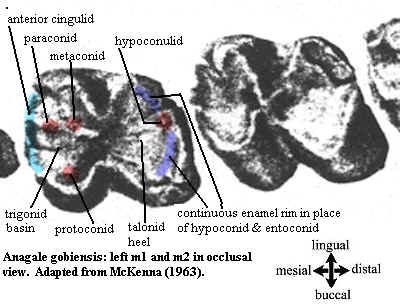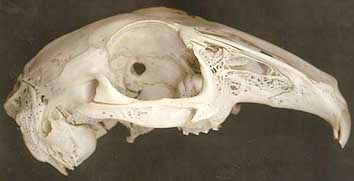
& Glires
| Palaeos |  |
Unit 470: Anagalida |
| Vertebrates | Anagaloidea & Glires |
| Page Back | Unit Home | Unit Dendrogram | Unit References | Taxon Index | Page Next |
| Unit Back | Vertebrates Home | Vertebrate References | Vertebrate Dendrograms | Glossary | Unit Next |
|
Abreviated Dendrogram
EUTHERIA |--XENARTHRA |--AFROTHERIA `--+--LAURASIATHERIA | `--+--EUARCHONTOGLIRES |--+--Anagalida | `--+--Anagaloidea | | |--Anagalidae | | `--Pseudictopidae | `--Glires | |--Lagomorpha | `--RODENTIA `--ARCHONTA |
Contents
Overview |
Range: Paleocene to Late Oligocene of North America & Asia
Phylogeny: Anagalida::: Glires + *: Anagalidae + Pseudictopidae.
Links: Anagaloidea ATW021028.
 Anagalidae:
Anagale, Anagalopsis, Anaptogale, Diacronus, Eosigale, Hsiuannania,
Huaiyangal, Linnania, Palasiodon?, Qipania, Stenanagale, Yuodon?
Anagalidae:
Anagale, Anagalopsis, Anaptogale, Diacronus, Eosigale, Hsiuannania,
Huaiyangal, Linnania, Palasiodon?, Qipania, Stenanagale, Yuodon?
Range: Paleocene to Oligocene of Mongolia.
Phylogeny: Anagaloidea: Pseudictopidae + *.
 Characters:
skull small [C88]; dentary condyle well above tooth row [C88]; auditory bulla formed from fusion of tympanic and entotympanic [Mc63];
dentary coronoid process short & recurved [C88]; P3 large & molariform, but with low cusps and with
protocone tilted forward [Mc63]; P3-P4 metacones weakly developed [S68]; P4 lingually high, with tall, vertical
protocone [Mc63]; upper molars with paracone & metacone near buccal margin
[C88]; lower molar trigonid
formed largely from metaconid & protoconid, with small paraconid anterior
& merged with metaconid [Mc63]; m1 with continuous enamel rim in place
of hypoconid & entoconid [Mc63]; m2 & m3 with successively more
distinct and separated cusps [Mc63]; manus with large, fissured claws [Mc63];
tibia & fibula separate with marked spatium interosseum [S68]; pes with fissured?, distally spatulate unguals [Mc63]; probably diurnal,
fore-foot digger [Mc63].
Characters:
skull small [C88]; dentary condyle well above tooth row [C88]; auditory bulla formed from fusion of tympanic and entotympanic [Mc63];
dentary coronoid process short & recurved [C88]; P3 large & molariform, but with low cusps and with
protocone tilted forward [Mc63]; P3-P4 metacones weakly developed [S68]; P4 lingually high, with tall, vertical
protocone [Mc63]; upper molars with paracone & metacone near buccal margin
[C88]; lower molar trigonid
formed largely from metaconid & protoconid, with small paraconid anterior
& merged with metaconid [Mc63]; m1 with continuous enamel rim in place
of hypoconid & entoconid [Mc63]; m2 & m3 with successively more
distinct and separated cusps [Mc63]; manus with large, fissured claws [Mc63];
tibia & fibula separate with marked spatium interosseum [S68]; pes with fissured?, distally spatulate unguals [Mc63]; probably diurnal,
fore-foot digger [Mc63].
Notes: [Mc63] makes a very strong case against archontan affinity. In McKenna's view, the anagalids are late-surviving variants of the ancestral Asian proto-rabbit stock.
Links: Die Ordnung der Primaten- Halbaffen (reflects former associations with Archonta); 30 September, 1996.
References: Carroll (1988) [C88]; McKenna (1963) [Mc63]; Sulimski (1968) [S68]. ATW031023.
 Pseudictopidae:
Allictops, Anictops, Cartictops, Haltictops, Paranictops, Pseudictops
Pseudictopidae:
Allictops, Anictops, Cartictops, Haltictops, Paranictops, Pseudictops
Range: Late? Paleocene to Early Eocene of Central Asia & North America
Phylogeny: Anagaloidea: Anagalidae + *.
Characters: badger or fox-size [S68]; zygomatic arch full & slender badger or fox-size [S68]; dentary moderately long, thick and tall [S68]; symphysis extends to p2 [S68]; dental formula 3/3,1/1, 4/4, 3/3 [S68]; unique canines, large, with posterior cutting edge, accessory cusps & denticles (very odd-looking!) [S68]; p3 & p4 protoconid taller than metaconid [S68]; p4 very molariform [S68]; molars with thin, lobate crowns [C88]; trigon & trigonid cristae short & sharp [S68]; upper molars twice as wide as long [S68]; trigon extended far lingually [C88]; P3-M3 hypocone very small or absent [S68]; P3-P4 metacones weakly developed as in Anagalidae [S68]; trigonids twice as high as talonids [S68]; molar metaconids taller than protoconids [S68]; p3-m3 paraconids strongly reduced [S68]; paralophid short, steep & lower than metalophid [S68]; tibia & fibula separate, but without spatium interosseum distally [S68]; tibia & fibula longer & more slender than in Anagalidae [S68]; astragalar trochlea almost symmetrical [S68]; hind limb with 5 digits, plantigrade to digitigrade [S68]; metatarsals II-IV, long with III the longest [S68]; pedal unguals fissured & proximally enlarged (not distally spatulate) [S68].
Note: [1] Note that the talonid shows the same general diamond shape as in the Anagalidae, with the same reduced talonid cusps. The paraconid is similarly reduced, and the parastylid may be homologous to a similar structure in Anagale, although the latter is very worn in the photograph above. The rhomboid shape of the talonid is produced in part by the presence of a pronounced cristid obliqua (or, one supposes, lophid obliqua in this case), which is a fairly distinct character. The cristid obliqua is the "one-armed" loph that proceeds mesiolingually from the hypoconid. We use loph, rather than crista to indicate that this is a cutting edge of enamel on a base of dentine. The dentine wears faster than the enamel, keeping the ridge sharp. The structure labeled metalophid probably ought to be the protolophid using our standard nomenclature.
References: Carroll (1988) [C88]; Sulimski (1968) [S68]. ATW030430
Glires: Eurymylus? rabbits & rodents.
Range: fr lwPc.
Phylogeny: Anagalida::: Anagaloidea + *: Lagomorpha + Rodentia.
Characters: Elongated snout with substantial (50%) contribution from growth of premaxilla [A+01]; jaw moves anterodorsally away from ear [L+87]; lateral alisphenoid canal for anterior trigeminal [L+87]; ever growing incisors and cheek teeth; reduced dentition; large, medial, & ever-growing procumbent i1 [A+01] (contra [FK02], not procumbent in Glires because strongly curved upwards); incisors with enamel restricted to outer surface near the crowns [A+01]; incisor enamel with Hunter-Schreger bands [A+01]; canines absent; large diastema between incisors & premolars; reduced number of premolars; coprophagy [L+87]; specialized cecum [L+87].
Note: Clearly the taxon Glires, first proposed by Linnaeus, remains controversial after literally centuries of debate. Even the scanty morphological description above would exclude the Macroscelidea. Incidentally, "glires" is the plural of the Latin glis = dormouse which, stuffed and/or in honey, was the Roman equivalent of a gourmet hot dog.
Links: Main Page; Glires I; Glires II; Origin of Rodents (interesting and useful undergraduate paper); Averianov (abstract); novembr6.html; THE THERIAN CLADE; JBC -- Graham et al. 271 (26): 15623; Phylogenetic analysis; mtDNA sequence of the fat dormouse; Fossil rodent from Inner Mongolia ; PNAS -- Reprint (PDF) Version: Li et al. 87 (17):6703; Rodent Phylogeny and a Timescale for the Evolution of Glires- ... (molecular phylogeny which agrees with morphological tree); MESOZOIC MAMMALS; Zalambdalestidae, Lipotyphla- and Cimolestidae ... (Zalambdalestidae may be near the root of Glires); Glires (rabbits, pikas, rodents) (brief definition); n414_1c 62..65 (a morphological tree also associating Zalambdalestidae with Glires); Brief report (questioning the previous article); ScienceDirect - Gene : Pika and vole mitochondrial genomes increase support for both rodent monophyly (molecular phylogeny depends on choice of outgroup).
References: Archibald et al. (2001) [A+01]; Fostowicz-Frelik & Kielan-Jaworowska (2002) [FK02]; Li et al. (1987) [L+87]. ATW031219.
 Lagomorpha:
rabbits & pikas.
Lagomorpha:
rabbits & pikas.
Range: from the Eocene?
Phylogeny: Glires: Rodentia + *.
Characters: Dental formula 2/1, 0/0, 3/2, 2-3/3. I2/1, with 2nd incisor immediately behind 1st, small and peg-like; incisors ever-growing, with at least some enamel on posterior, as well as anterior, face; flaps of skin can meet behind incisors (can gnaw with mouth closed); C0/0 with large diastema; cheek teeth hypsodont, rootless (in R forms), with transverse ridges; lower cheek teeth laterally closer than uppers, so that only one side occludes at a time and lateral grinding is required; masseter and pterygoideus large; coronoid process and temporalis reduced; fenestrated skull bones, i.e. with areas of thin, lattice-like bone (esp. maxilla & parietals -- see leporidae.jpg); auditory bulla from ectotympanic only & entotympanic is absent; tail reduced or absent; elbow joint limits forelimbs to antero-posterior motion; tibia & fibula distally fused; digits 5/4-5; soles of hind feet generally furred; stance digitigrade when moving quickly; all herbivorous, with very large cecum; various specializations for rapid reproduction including induced ovulation (eggs shed in response to copulation) and ‘postpartum estrus’ (can conceive immediately after giving birth).
Note: There are some peculiar parallels between lagomorphs and protoavian dinosaurs, e.g. fenestrated bone, forelimb motion; distal limb fusion, & possibly others.
Image: Oryctolagus cuniculus © 1999 by BioImages, used by permission.
Links: Order Lagomorpha; Rabbit, Hare, and Pika Skulls from Skulls Unlimited ; Kazimir Majorinc Pika Page; Order Lagomorpha; Lagomorpha; Mammalia: Rodentia und Lagomorpha; Entrez-PubMed (abstract); Order Lagomorphia; Lagomorphs; Untitled Document; Leaping Lepus - The Hall of Florida Fossils; Oklahoma Museum of Natural History; LITERATURA DE LAGOMORFOS EN CHILE DESDE 1847; Order LAGOMORPHA; Lagomorphs - EnchantedLearning.com; Order Lagomorpha; ???? (CSIS); Lagomorpha. ATW030406.
| Page Back | Unit Home | Page Top | Page Next |
checked ATW040121